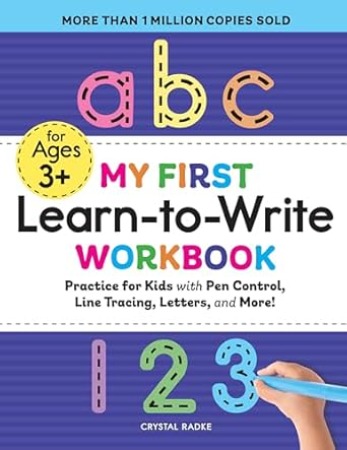My First Learn-to-Write Workbook: The Secret Behind Its Success
Discover the reasons behind the monumental success of 'My First Learn-to-Write Workbook' by Crystal Radke. Explore the author’s background, the workbook’s structured approach to early education, its engaging content, and endorsements from credible educators. Learn how these elements contribute to its popularity and effectiveness as an educational tool for young children.
Table of Contents
My First Learn-to-Write Workbook: The Secret Behind Its Success
In today's fast-paced digital age, where tablets and touchscreens dominate, it’s refreshing to see a tool that brings us back to basics—pen and paper. My First Learn-to-Write Workbook: Practice for Kids with Pen Control, Line Tracing, Letters, and More by Crystal Radke has become a monumental success, selling over a million copies. So, what’s the magic behind this bestselling workbook? Let's delve into its unknown side and uncover the fundamental reasons for its triumph.
The Crystal Radke Phenomenon
First off, it’s essential to understand the author behind this success. Crystal Radke is not just a bestselling author; she is an educational leader and public speaker with hands-on experience as a kindergarten teacher. This isn't a workbook churned out by a faceless corporation but a labor of love from someone who has been in the trenches of early childhood education. Her journey from the classroom to becoming a consultant who mentors early childhood educators speaks volumes about her dedication and expertise. Her credibility and passion are woven into every page of this workbook.
A Thoughtful Approach to Early Education
One of the critical elements that set this workbook apart is its thoughtful, structured approach to learning. The workbook starts with basic pen control and line tracing before gradually introducing more complex tasks like letter and number formation. This progression is not random but rooted in developmental psychology, ensuring that each step builds on the previous one. It’s this meticulous attention to developmental appropriateness that makes it an invaluable resource for both parents and educators.
Engaging and Fun
Let’s face it—keeping a 3 to 5-year-old engaged is no small feat. Crystal Radke understands this challenge and has peppered the workbook with colorful, slightly silly illustrations that capture the imagination of young minds. The workbook contains over 75 practice pages filled with diverse activities like connect-the-dots and fill-in-the-blanks. These activities offer enough repetition for real learning but are varied enough to keep kids interested. In a world where digital distractions are rampant, this workbook manages to make learning fun and engaging.
Endorsements That Matter
Another reason for the workbook’s success lies in its endorsements from credible sources. Take Melissa Middlebrook, a classical home educator, who praises the workbook for its balance between writing and typing in an era dominated by screens. Or Kaci Hoffer from Mrs. Hoffer's Spot, who highlights how the book’s format—moving from strokes to shapes to letters—is perfect for developmental stages. Then there’s Vanessa Levin, an early childhood educator and consultant, who emphasizes the workbook’s ability to guide parents and teachers through pre-writing skills. These endorsements are not just fluff; they come from seasoned educators who recognize the workbook's value.
The Bigger Picture
Beyond the pages of the workbook, there’s a more significant cultural and educational shift at play. Parents and educators are increasingly recognizing the importance of foundational skills like penmanship and fine motor skills in an era where digital literacy often takes precedence. This workbook taps into that growing awareness, offering a tangible, effective tool to help children succeed in school and beyond.
How to Imitate This Success
If you’re an aspiring author or educator looking to create your own successful educational tool, here are a few takeaways from Crystal Radke’s masterpiece:
- Know Your Audience: Understand the developmental stages and needs of your target age group. Design your content to be both educational and engaging.
- Build Credibility: Leverage your own experiences and credentials to build trust. Crystal’s background as a kindergarten teacher and educational consultant adds immense value to her work.
- Structured Learning: Ensure that your content follows a logical, developmentally appropriate progression. This helps in making the learning process natural and intuitive.
- Engagement is Key: Use colorful illustrations and varied activities to keep young minds engaged. Learning should be fun, not a chore.
- Seek Endorsements: Garner support and endorsements from credible sources in your field. This adds an extra layer of trust and validation to your work.
In conclusion, My First Learn-to-Write Workbook isn’t just a bestseller because it’s a workbook; it’s a bestseller because it’s a well-crafted, engaging, and credible educational tool that meets the needs of both children and their educators. Crystal Radke’s dedication and expertise shine through, making this workbook a must-have for any parent or teacher aiming to set their little one on the path to success.
Buy My First Learn-to-Write Workbook on Amazon
Feel free to share your experiences or thoughts about this workbook in the comments below! Have you used it with your child or students? What was your experience like? Let’s keep the conversation going!
Story updated onSeptember 3, 2024
Table of Contents

My First Learn-to-Write Workbook: Practice for Kids with Pen Control, Line Tracing, Letters, and More
Crystal Radke